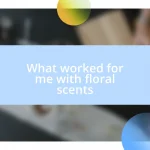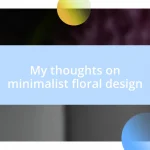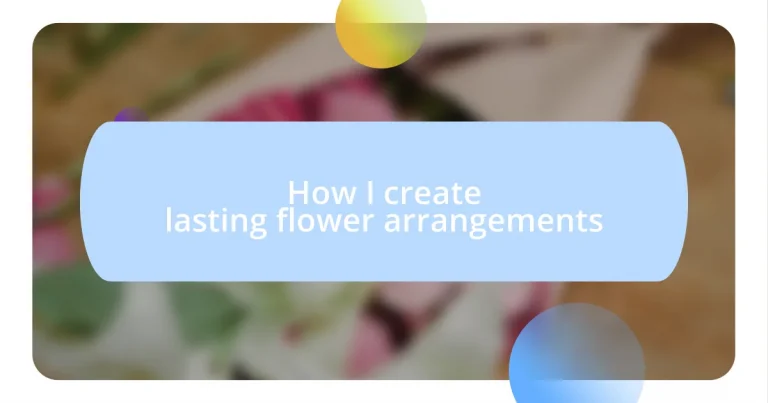Key takeaways:
- Choose seasonal flowers and understand their symbolism to create arrangements that resonate emotionally and aesthetically.
- Prepare your tools and workspace thoughtfully; maintaining sharp tools and a tidy area enhances creativity and results in better arrangements.
- Care for arrangements by changing water regularly, trimming stems, and avoiding direct sunlight to extend their freshness and beauty.

Choosing the Right Flowers
Choosing the right flowers can be a delightful yet daunting task. I often find myself wandering through the local market, feeling overwhelmed by the vivid colors and lush varieties. Have you ever stood in front of a bouquet and felt an instant connection to one particular bloom? It’s in these moments that I often let my heart guide my choice, because flowers have a way of conveying emotions that words cannot.
Consider the season when selecting your flowers. In my experience, seasonal blooms not only tend to last longer but also reflect the beauty of their environment. For instance, last spring, I opted for peonies and ranunculus, both abundant and vibrant during that time. The result was a stunning arrangement that captured the essence of the season, and every time I glanced at those flowers, it reminded me of warmer days and fresh beginnings.
Don’t forget to think about the purpose of your arrangement. Are you decorating for a joyful celebration or a somber occasion? Each flower carries its own symbolism; for example, lilies tend to convey a sense of peace while sunflowers radiate happiness. I remember creating a centerpiece of bright sunflowers for a friend’s birthday, and the room instantly filled with warmth and cheer. What mood do you want to create? Understanding the emotional backdrop can greatly influence your choice of flowers.

Preparing Your Tools
Preparing your tools is an essential step that often goes overlooked. I’ve learned the hard way that having the right equipment makes all the difference. There’s something satisfying about working with well-maintained tools, just like a chef feels about sharpened knives.
Here’s a quick list that can help you gather everything you need:
- Sharp scissors or garden shears: These ensure clean cuts, allowing your flowers to absorb water better.
- Vase or container: Choose a size and shape that complements your arrangement style.
- Floral tape or wire: Great for securing your stems in place and providing structure.
- Water: Fresh, clean water is crucial; I always make it a point to fill my vases with warm water to help the flowers hydrate.
- Flower food: This helps nourish the blooms and extends their lifespan; I swear by it for longer-lasting arrangements.
When I start preparing my tools, I always make sure my workspace is tidy and inviting. I find that this not only sparks creativity but also prevents the frustrations that can arise from a cluttered area. There have been times when I was so eager to begin arranging that I neglected to check if my scissors were dull, resulting in an uneven cut. It’s those little details that can turn a beautiful arrangement into a stunning one. When everything is within arm’s reach, I feel more connected to my crafting process, making each arrangement even more special.

Selecting the Ideal Container
Selecting the right container can truly make or break your flower arrangement. I remember the first time I created a bouquet for my home; I chose an ornate glass vase that seemed perfect in the store but didn’t complement the flowers I picked. It taught me that the ideal container should enhance the beauty of the blooms, not overpower them. I often envision the finished arrangement in my mind; this helps ensure harmony between the flowers and the container.
When considering your options, think about materials as well. Each type has its own characteristics. For example, ceramic tends to maintain moisture well but can be heavy, while glass is elegant and allows for a beautiful view of the stems. I’ve used both types in my arrangements, and while the ceramic emerged as more practical for certain flowers, the glass added an artistic touch for others. Have you ever thought about how the weight of a container might affect your display? It’s something I often pondered after nearly knocking a delicate arrangement off a table because I had chosen a too-light container.
Size is another vital factor to consider when selecting your container. You want to ensure that it is proportional to the flowers and the environment. A compact arrangement in a small jar can fit beautifully on a dining table, while a large, statement piece demands attention in a living room. I remember once creating a dramatic look with an oversized vase filled with wildflowers; it became a conversation starter during get-togethers! Finding that balance between size and shape can elevate your arrangement from ordinary to extraordinary.
| Container Type | Materials |
|---|---|
| Ceramic | Good for moisture retention |
| Glass | Elegant and visually appealing |
| Plastic | Lightweight and versatile |
| Metal | Durable and modern look |

Arranging Flowers for Impact
Arranging flowers for impact goes beyond merely placing stems in a vase; it’s about creating a visual narrative. I often think about the story each arrangement tells. For instance, when I crafted a centerpiece for my friends’ wedding, I chose blushing peonies paired with delicate white blossoms. The combining colors not only symbolized love but also caught everyone’s eye, sparking conversations throughout the evening.
Considering the placement of each flower is crucial. I used to just stick flowers wherever I thought they might fit, but now I play with heights and angles. The first time I experimented with a cascading effect using ivy, I found it added such a dynamic touch. Have you ever noticed how your eye is drawn to the most striking elements in an arrangement? That’s the power of intentional placement. Each bloom should complement the others, creating a harmonious flow that captivates.
Texture is another key element to consider. I remember the thrill of combining soft blooms with spiky foliage; it added depth and interest. Mixing textures not only makes an arrangement more inviting but also creates an emotional resonance. Think about it: doesn’t a varied texture pull you in closer, encouraging a deeper appreciation of the flowers? That’s what I aim to achieve with each creation—a lasting impression that will stay with viewers long after they’ve walked away.

Adding Filler and Greenery
When it comes to adding filler and greenery, I’ve learned that they’re essential for grounding a flower arrangement. I remember a time when I left out the greenery entirely, thinking it might overshadow the blooms. But when I revisited that choice, the arrangement felt flat and uninspired. Incorporating fillers like ferns or my personal favorite, eucalyptus, adds not only volume but also a refreshing contrast that draws the eye. Have you ever marveled at how the right greenery can transform a bouquet? It’s almost like a secret ingredient that ties everything together.
I often use fillers to create a visual rhythm, guiding the viewer’s gaze throughout the arrangement. For instance, when I added delicate baby’s breath to a vibrant summer mix, I noticed how it softened the bold colors and gave the entire piece a dreamy quality. It’s fascinating how such small elements can create a sense of movement and flow. I once crafted a centerpiece for a family gathering using a mix of wildflowers and foliage; the way the greenery hugged the blooms made everyone at the table feel more connected to the arrangement, almost as if they were part of its story.
Then there’s the emotional aspect of filler and greenery. They evoke a feeling of fullness, as if nature itself is embracing the flowers. I recall decorating my living room with an arrangement of sunflowers and trailing ivy; it filled the space with a sense of warmth and vitality. It’s remarkable how these subtle details can shift the atmosphere of a room, inviting not just beauty but a sense of peace and joy. Do you think about the emotions your arrangements convey? I’ve found that a well-placed leaf or filler can speak volumes about the care and intention behind each creation.

Caring for Your Arrangement
When caring for your flower arrangement, it’s essential to change the water regularly. I remember one summer when I was so enamored with my vibrant bouquet that I neglected this task for a few days. The once fresh blooms quickly began to wilt, and I realized that dirty water can harbor bacteria that shorten their lifespan. A simple swap every two days can keep them looking lively and vibrant for longer.
Furthermore, I find that trimming the stems helps a lot with sustaining freshness. Each time I cut the ends at a diagonal, it creates a larger surface area for water absorption—something I learned after a particularly frustrating week where my flowers struggled to thrive. Have you ever experienced that disappointing moment when your arrangement doesn’t live up to your expectations? A quick trim can work wonders, revitalizing them and ensuring they feel wonderfully alive.
Lastly, positioning your arrangement away from direct sunlight can significantly extend its beauty. I made the mistake of showcasing my favorite flowers on a sunlit kitchen table last fall, only to watch them droop by day’s end. The heat can be relentless! Now, I tend to place my arrangements in cooler areas, allowing them to bask in their beauty without the harsh glare. It’s those small adjustments that remind me just how much care goes into keeping a flower arrangement thriving. What strategies have you found helpful in nurturing your own creations?

Tips for Long Lasting Freshness
One of the best tips I’ve discovered for maintaining long-lasting flower freshness is to use flower food. Early on, I often overlooked those little packets that come with bouquets, but after a particularly vibrant batch of tulips began drooping, I decided to give it a try. The difference was night and day! The preservatives in flower food provide crucial nutrients that help blossoms thrive. Have you ever noticed how flowers seem to come alive after a good drink of this magical mix?
Another surprisingly effective method involves adding a few drops of bleach to the water. Initially, I was skeptical; bleach sounded harsh! But I learned from a floral workshop that even a tiny amount can help keep bacteria at bay, prolonging freshness. I tested this out with a colorful mix of daisies and ranunculus, and I was thrilled to see the arrangement lasting an entire week longer than usual. It’s a simple trick that seems to defy logic—isn’t nature full of delightful contradictions?
Lastly, consider the temperature of the water you use. Cold water might seem like the best option—after all, who doesn’t love a refreshing drink? I discovered, however, that warm water encourages faster hydration for certain blooms like roses. The first time I tried this, my dinner party flowers looked radiant, much to my delight. I often wonder if we could learn something about self-care from our flowers; sometimes, a little warmth in our lives can make all the difference, don’t you think?














